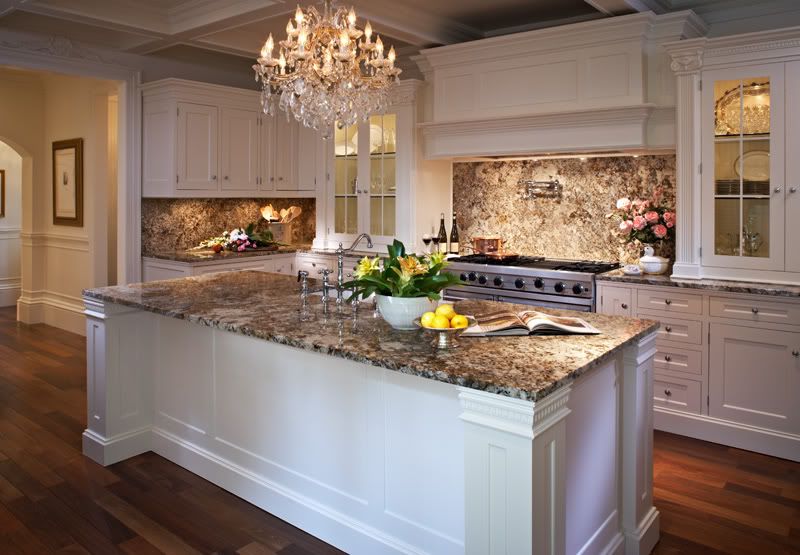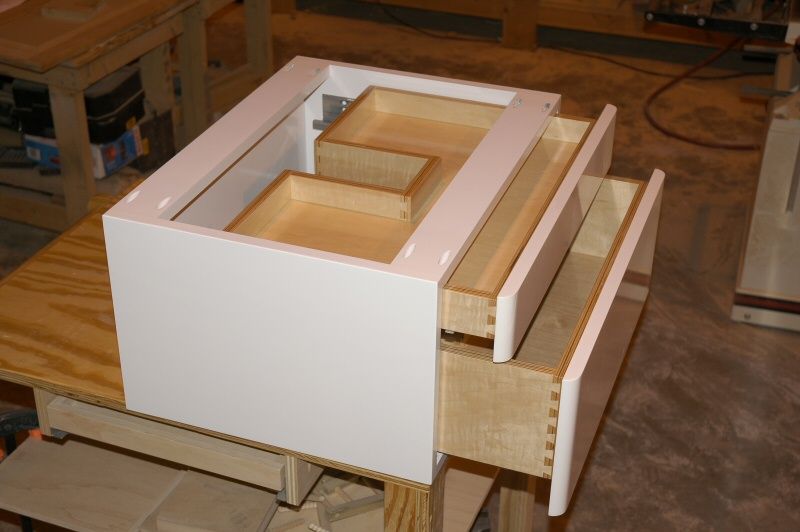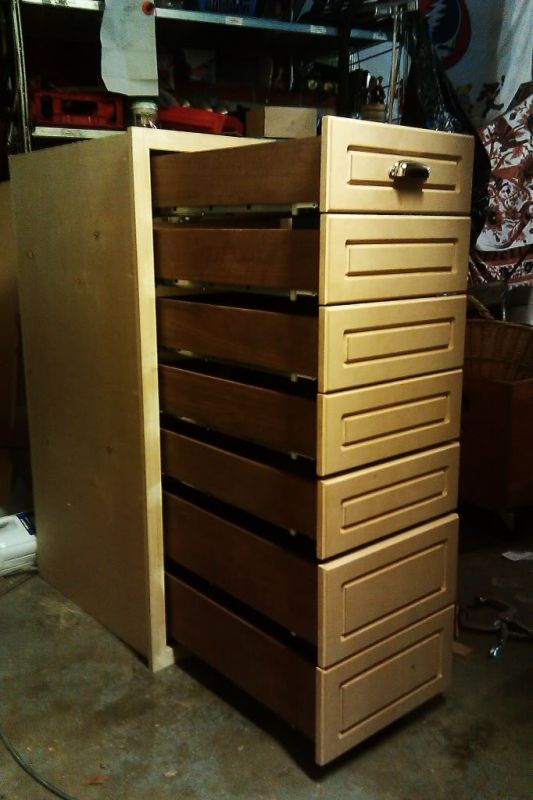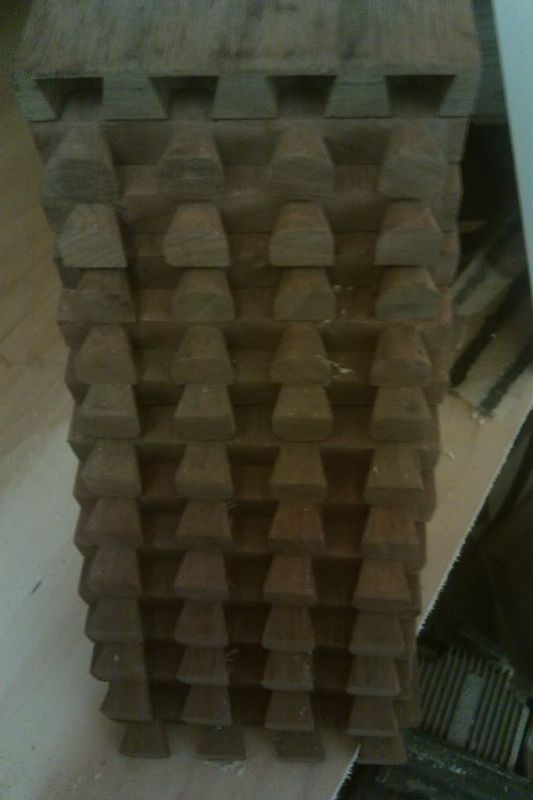Question
I have been doing some higher end kitchens lately. The designer (being ignorant to methods and engineered wood) has me making solid walnut or oak drawer boxes. I am getting ready to start another kitchen, and wondering if anyone has opinions on using these woods for drawers.
I have had great results so far, no binding or warping. But it has only been a couple of years since I started building these. I dovetail every side, even the back. I use 5 sided drawers so I can replace the face if necessary without destroying the whole box.
I have tried to convince him to use laminated boxes, and edgeband the top edges to look solid. Is this worth it? Will it take more time than solid? Of course, the problem is the dovetails will show the laminate structure. I may be better off sticking with solid wood.
I have been using 1/2" material for drawers under 8" high, or under 15" wide, and 3/4" for anything bigger. Another option we have been trying is retrofitted boxes, to sit inside existing plywood boxes with a lip to cover the laminate. They come flush with the face on the top, and really make a nice product. The picture is of my first kitchen. You can see why he wants solid drawers!

Forum Responses
(Cabinetmaking Forum)
From contributor D:
What kind of guide system are you using on those drawers? I assume a quality soft close undermount such as Blum Tandem. With that type of guide, the sky is the limit on what type of drawer material and construction method for your drawer system. I have a preference for matching the drawer material to the exterior wood and a dovetail always seems like the choice for solid wood.
Prefinished plywood would be a good choice in a painted look kitchen, either doweled or screw pocket for construction, especially if you are using prefinished plywood on the box interiors.
Why do you fit a laminate box inside another box? Melamine or HP laminate can make a good drawer in itself, with the proper construction method.
Most of the wood drawers we install are either solid dovetail, outsourced, or prefinished ply doweled and banded with either matching 1mm PVC or 1mm wood, almost always on Blum Tandems.
I use undermount gliders, although sometimes side mount heavy duty soft close slides. I know what you mean about undermount. Even if the drawer swells, it still slides fine in the opening. With side mount, it can bind if it swells.
I prefer to make my own drawers. I don't outsource anything. At this point, the clients want to know the same guy made every piece, and I work alone. So I can honestly say my hands formed and cut every piece, and set every screw. It is an honor, since I know many larger outfits have no choice but to outsource doors and drawers. At that point, all you are is a box maker, in my opinion. The skill is in the design and installation, as well as the components. Drawers get a lot of abuse. I know even in some of the best outfits, seldom do they dovetail the back of the drawer, since it is seldom seen. But I do it just to be safe. And for that extra point of quality.
Since I buy s2s material, then plane, joint and sand it to shape, every drawer box takes me about an hour. I would get eaten alive if I tried to market that to the average homeowner. But I have no employees, and little overhead, so I can take my time and do it right.
Some clients ask if I can drop my quote. No discounts - it is what it is. If they want something else, find the boxmaker down the street. We also build our own doors and mill our own moldings.

I have tried the Baltic birch and it works. But what I hate about it is the birch is really fragile on the edges and has a tendency to flake. What I especially hate is when you are sanding the corners to break the edges, you get those spear slivers. Those suckers really hurt. Doesn't happen with the Euro maple.
Contributor A, they can get anything they want, as long as they want to pay for it. The Euro maple dovetail drawer with Blum soft close slides is my standard.
We just got done painting about $200,000 worth of clear finished fir. Huge beams and panels, soffits, cabinets. All done to perfection, not one knot in the house. The house was 2 years old. The new owners wanted it brightened up. It was a real bummer.
Anyway, I see that it becomes a pissing match between solid or engineered boxes. It shouldn't be. Nobody is wrong; it all comes down to what the customer wants. I would use ply boxes if I had the money to refinish my kitchen. Just because I don't feel the need to brag about solid wood. It saves money and trees!
Below, note what I mean. The cabinet was a linen drawer setup for a client, using solid white oak drawer boxes… and MDF fronts! What a contrast of quality!

I don't mind building a dovetailed drawer box from solid wood. Otherwise I use Baltic birch plywood.
We have a commercially made vanity in our house that is a couple of decades old and the drawers are just particleboard, stapled with lap joints, and lots of hot melt. The bottom panel even on the narrower drawers is either 1/2" or 5/8" particleboard rebated into the groove and glued with hot melt all the way around on all 4 edges on the bottom of the drawer. I have to say they feel solid, and have held up just fine.
I do not like to use laminate (I assume you mean melamine?) in a nice kitchen. Nice Baltic birch ply is not much more expensive and looks great dovetailed.
I would tell the designer/contractor that softwood and plywood are better structurally than hardwoods for drawers. I suspect he will believe you. If he insists on hardwood for the visual effect, then you shouldn't argue with him. Dovetailed hardwood will hold up for decades.
I try to rip, cut and plane my lumber a week before I make doors or drawers. This gives time for any stress to show and any bad kiln work to start to show. Then the same day we make the doors/drawers, we give the lumber a final dressing in the planer and re-joint as needed.
I am located in southeast Asia so I use a lot of teak, mahogany, and other jungle wood. Kiln drying is very unreliable as well. Most homes here cycle between the extreme humidity of a jungle and the dry cool air conditioning on a monthly basis. This all means I have to deal with extreme wood movement. I use dowels for most of my drawers and never have failures. Dovetails are even better, but not necessary from a practical standpoint.
Suggest to your client that using ply or softwoods will save them money and it is a better use of these rare resources. Most will respond to the notion that nice wood is a rare and valuable natural resource that needs to be conserved so that future generations can enjoy it also. Glad you are keeping high standards in your shop. I hope you have continued successes.
Oak is plentiful; many tropical woods are not. I live in the Pacific Northwest... No shortage of oak here!
I have discussed using plywood with the designer, but honestly, I am really glad he stuck with solid. It is much more personal than all that laminated crap. I like taking my time and feeling out the wood and grain patterns. Also, they feel much more solid than ply. Our kitchens are $785 a foot, so we can afford to spend the extra money on material. If I am going to dovetail them anyway, I don't want all those plies showing in the finished product.
I am not suggesting the kitchen is not nice. I would be proud to have my company name on that picture. I am suggesting dovetailed hardwood drawers are a little out of range for that type of kitchen. If the client wants to pay for the upgrade I will put my best drawer in my cheapest cabinet, but for most jobs it would add 20 or 40% to the cost. The kitchen shown would cost considerably less if I used system drawers or doweled ply boxes vs. dovetailed hardwood.
Again the client usually gets what they want, but I would never try to sell such an "upgrade." I would tell the client we could spend that money on nicer hardware or something else. I also think that all the drawer methods discussed so far are equally durable, so why waste the lumber and cash on something like that?
I've never placed a finished solid wood box next to a ply box and thought it looked better. The same way I wouldn't with a door. More often than not, I think "what did you do, run out of money?" The customer thinks of it as cheaper, not because it is engineered with less enthusiasm, but because it is made with cheaper materials and associated with lower-end. And when they are spending thousands on a kitchen, saving a couple hundred bucks max by using ply versus solid doesn't make much sense.
Kind of like buying a Mercedes and getting standard cloth interiors. You can do it, but is that what a Mercedes is all about? For some, yes. They would just rather be able to say they have a Mercedes.
To me, it's not just about the dovetail drawers but rather what else goes inside - the complete package, like cutlery dividers, plate dividers, etc. that they will show off to those visiting their home. Looking at a beautiful exterior and then opening the drawers to the same ply boxes that are in low-end kitchens makes an impact, and usually not as good of one.
Wood is a replenishable resource that neither generation has to necessarily conserve or do without. If one has to conserve it, why not the other?
To answer the original question… "Solid dovetailed drawer boxes; worth it?" If for no other reason than marketing... Yes! Our industry spent a long time convincing customers of the merit of solid wood. Trying to reverse course now would most likely be met with suspicion of the one who really benefits.
If a couple hundred is that important when spending thousands, so be it. Nothing wrong with giving them the option. Just be careful when the competition comes along and offers it for the same price with solid. Better off just closing it right there and then.
I would not push solid wood drawers for kitchen cabinetry. I can make drawers (dovetailed or doweled) much faster from ply. I can rip, groove and cut to length a sheet of drawer parts in 30 minutes. It takes me at least an additional 2 or 3 hours to turn solid wood (clean S4S is not available in my market, so I start from 4/4 rough lumber). Also I have found it prudent to pre-mill all lumber a week before the project starts to minimize movement problems later. Add to that the trip to the lumberyard and sorting out defects and… I think you get my point. It takes me a lot more time to make solid wood drawers. Perhaps you guys have better machines or know something about milling lumber I have yet to learn.
In America I used to push dovetails. Almost every client had to be educated on what a dovetail joint even is! It took me years to realize that I was not offering something the client really wanted - I was just creating more work for myself. Sometimes I convinced them that dovetails are better, but I suspect I lost work by pushing the client's budget in a direction they didn't really care about; and dovetails are only one of these "false value added" upgrades I tried to sell. It is the equivalent of a car salesman pushing a backup camera or the famous undercoating.
I have standard pricing for dovetail drawers (solid or ply), so if the client asks I will quote it accordingly. In fact I have a mahogany dovetail drawer in my showroom along with melamine, ply and system drawers. In the last 2 years I have only had contractors comment on the dovetailed drawer. They never want me to use them, rather they were impressed that we offered it as an option.
Instead I listen to the clients and try to sell them what they want. They usually show an interest in the finishing, hardware and most of all the overall design. I have a licensed professional designer (she is talented as well). I sell her service more than anything else. I do not bore them with details about our construction techniques. If they are curious I explain in very simple terms. Even better I have professionally designed marketing materials that do this for me using pictures and simple language. It is all put in our pretty company folder with our company profile and other information they may or may not be interested in. I spend our valuable face time trying to uncover the details locked in their brains that they did not know to say. Most of this relates to design, not engineering.
It sounds like this designer likes dovetailed drawers, so sell them what they want. If you don't want to make them, or if you can not make the same margins when making them, suggest they consider an alternative. But I would not shoot a gift horse in the mouth.
Like I said, I would be proud to have my name associated with the kitchen you made, and I do not offer such compliments often. If dovetails are what they want, then do it. I am guessing the client was willing to pay for it. I think most clients would be just as happy with doweled ply. I also think doweled ply drawers will last just as long and will have a reduced risk of callbacks due to warping and cracking.
You are doing some nice work but you should probably pay a little more attention to details, especially in the planning stages. Your kitchen above looks nice but I noticed that you made the upper cabinets on the left of the picture too long and your cabinet crown had to cope to the door casing. This type of thing can turn a high end kitchen into an average one. It should not be done. Do you use software to design? The software can make you aware of mistakes like that before you build the job.
Same goes with ply boxes. If you band it and dovetail it, it draws attention, and if you don't band it, you still see the ply edges. And that is what people seeing it will compare it to. It kind of smacks the project in the face, when they spent thousands on a kitchen, and save a couple of hundred bucks to go from solid wood to ply? It's all in the details and what sets you apart (both good and bad).
Will it make a difference in the function? Not in the least. Will it affect its perceived value? Beauty is in the eye of the beholder. And perception is reality (a perception/reality we as an industry created).
And contributor Y, if you think dovetails are a perceived value, you are perceiving that doweled plywood boxes are quality. They are made for a reason, and it's not decoration. Have you ever tried to break a dovetail drawer? Then a doweled plywood one? Sure, plywood will hold up and function fine. But dovetails are far from being ornamental.
Real customers in the right circles know exactly what they want. And they are educated. They do understand the difference in quality - it is common sense. If it was just for decoration, we would glue fake dovetails on a stapled plywood box. Your average homeowner may have never heard of a dovetail, but head to the nice part of town, and that changes. These are the people that pull out their drawers to show their neighbors that there are dovetails in the back!
Also, how many of you make 5 sided drawers compared to 4 sided? I think 5 sided drawers are more forgiving, but am curious how many customers care if the front is integrated?

If I understand you correctly, I have likely made a lot more dovetailed drawers than you. Before I made my own I ordered them from DBS and Conestoga. I had one of the first Thermwood routers running nested dovetails. The tooling was still experimental at that time. I never had a dovetail box fail. But guess what? I have never had the dowels on a melamine box fail either. I have had all kinds of other failures, but no dowel failures. My point is justifying dovetails because they are stronger is silly. I agree they are more beautiful and my personal kitchen has them. I will be hand cutting dovetails this week for my personal cigar box! And it is all purely aesthetic.
Again, I apologize for my comments about paint grade cabinetry. Your original post seemed to indicate you do not want to use hardwood for your drawers. I agree that is unnecessary and likely less reliable than ply boxes. I also agree with the idea that dovetailed, hardwood drawer boxes seem unnecessary on a paint grade job. In fact I prefer to use maple or beech so it will match better.
If you are justifying dovetails because it makes a better engineered cabinet, I do not agree. But if you are saying dovetails denote a higher end job, I do agree.
If you already decided you want to make hardwood dovetailed drawer boxes, go for it. If you want to hear from the experience of others, read these posts. In the end it is your choice to make. In my case, despite making very nice kitchens, I quit pushing dovetails.
Contributor F summed it up perfectly: "All of my clients want them if I don't charge extra." That, my friend, is definitely not a value added service. Offering to do extra work that the client will not pay extra for is a waste. It is bad business. If your clients will pay for it, then sell it. That is what I do.
Present your best product at the price you need to operate. Just like wood, once you take it off, it's hard to get back on again. So better to start off with solid wood dovetails, and work back from there. Therefore, you don't have to include dovetails at the lower cost, but rather they step down from the ideal to get the better price, and you don't pay for it, negotiating at a loss.
Start off with melamine boxes, doweled or not, and then when they hit you with "I want solid wood dovetails, but I want it at this price," you will find it much harder to regain money lost. Don't put yourself in the position when negotiating of being the party who is giving up something.
That said, I agree with starting with the best materials and working back from there. It allows us more flexibility for sure, without having to raise our prices. If you start with the best, and your price works, you are in a good position. But I know that many cabinet builders use what they know, and what they are used to. This is the same for all phases of carpentry.
Contributor Y, you are right, you have probably done a thousand more boxes than me. It's just that I started out using solid wood, and I have never used plywood before. I don't care either way. The designer decides that usually, although I do try to educate him.
I guess now that I have thought about it, our kitchens are sold on our hardware and drawer materials. We have paint grade faces, nothing special. I prefer to use melamine on all my carcasses, though many consider it a cheap material. I look at it like anything else - what is going to give the best result? While wet melamine could be a nightmare, I see no use in painting the inside of the cabinets. So I use it. The same can be said about plywood. It is probably a much better product for drawer boxes, but to most consumers it is all about what they can see.
So my point is, every builder has his own methods; whatever works for you. I can see now that the cost for material is the same, and the labor is about the same. One thing is the prep work for the rough lumber, but I could prep a whole kitchen worth of drawers in a few hours, just planing and jointing to rough dimensions.
So for now I will stick with solid, and if a future client wants to save money, I can start there and work my way down to his budget if I so desire. I think that's the way to go. This is still all relatively new to me, so it's good to have input.
Editor's Note: Macoser, Inc. (website) is the exclusive importer for Omec machinery including dovetail machines and gluers.